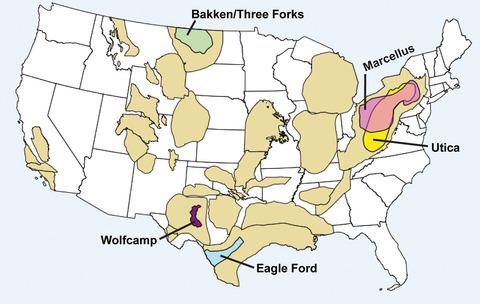当前位置:
X-MOL 学术
›
Geostand. Geoanal. Res.
›
论文详情
Our official English website, www.x-mol.net, welcomes your
feedback! (Note: you will need to create a separate account there.)
Direct Trace Element Determination in Oil and Gas Produced Waters with Inductively Coupled Plasma‐Optical Emission Spectrometry: Advantages of High‐Salinity Tolerance
Geostandards and Geoanalytical Research ( IF 2.7 ) Pub Date : 2020-04-09 , DOI: 10.1111/ggr.12316 Aaron M. Jubb 1 , Mark A. Engle 1 , Jessica M. Chenault 1 , Madalyn S. Blondes 1 , Cloelle G. Danforth 2 , Colin Doolan 1 , Tanya J. Gallegos 1 , Dan Mueller 2 , Jenna L. Shelton 1
Geostandards and Geoanalytical Research ( IF 2.7 ) Pub Date : 2020-04-09 , DOI: 10.1111/ggr.12316 Aaron M. Jubb 1 , Mark A. Engle 1 , Jessica M. Chenault 1 , Madalyn S. Blondes 1 , Cloelle G. Danforth 2 , Colin Doolan 1 , Tanya J. Gallegos 1 , Dan Mueller 2 , Jenna L. Shelton 1
Affiliation

|
Waters co‐produced during petroleum extraction are the largest waste streams from oil and gas development. Reuse or disposal of these waters is difficult due to their high salinities and the sheer volumes generated. Produced waters (PWs) may also contain valuable mineral commodities. While an understanding of produced water trace element composition is required for evaluating the associated resource and waste potential of these materials, measuring trace elements in brines is challenging due to the dilution requirements of typical methods. Alternatively, inductively coupled plasma‐optical emission spectrometry (ICP‐OES) has shown promise as being capable of direct measurements of trace elements within PWs with minimal dilution. Here, we evaluate direct ICP‐OES trace element quantification in PWs for seventeen trace elements (As, Al, Ba, Be, Cd, Cr, Co, Cu, Hg, Mo, Ni, Pb, Rb, Sb, U, V and Zn) within fifteen PWs from five U.S. continuous reservoirs. The total analytical uncertainties associated with the trace element levels determined using ICP‐OES were estimated to be better than ± 30% (2s) except for Rb, which could not be determined due to ionisation interferences. The ICP‐OES results are compared with trace element levels determined using inductively coupled plasma‐mass spectrometry from the same samples. Our results demonstrate the potential for direct analysis of high‐salinity waters using ICP‐OES with minimal dilution and provide trace element concentrations in waters from several important U.S. petroleum‐generating reservoirs where available data are sparse.
中文翻译:

电感耦合等离子体发射光谱法直接测定油气采出水中的痕量元素:高盐度耐受性的优点
石油开采过程中共同产生的水是油气开发中产生的最大废物流。由于它们的高盐度和所产生的巨大体积,很难再利用或处置这些水。产水(PW)也可能包含有价值的矿产商品。虽然需要了解产出水中微量元素的组成,以评估这些材料的相关资源和浪费的可能性,但由于典型方法的稀释要求,因此在盐水中测量微量元素具有挑战性。另外,电感耦合等离子体发射光谱法(ICP-OES)有望以最小的稀释度直接测量PW中的痕量元素。在这里,我们评估了PW中ICP-OES对痕量元素(As,Al,Ba,Be,Cd,Cr,来自五个美国连续油藏的15个PW中的Co,Cu,Hg,Mo,Ni,Pb,Rb,Sb,U,V和Zn)估计与使用ICP-OES测定的痕量元素相关的总分析不确定性优于±30%(2s),但由于电离干扰而无法确定的Rb除外。将ICP-OES结果与使用相同样品的电感耦合等离子体质谱法测定的痕量元素水平进行比较。我们的结果证明了使用ICP-OES进行最小稀释的高盐度水直接分析的潜力,并提供了来自几个重要的美国石油生产储集层的水中痕量元素的浓度,这些数据都很少。
更新日期:2020-04-09
中文翻译:

电感耦合等离子体发射光谱法直接测定油气采出水中的痕量元素:高盐度耐受性的优点
石油开采过程中共同产生的水是油气开发中产生的最大废物流。由于它们的高盐度和所产生的巨大体积,很难再利用或处置这些水。产水(PW)也可能包含有价值的矿产商品。虽然需要了解产出水中微量元素的组成,以评估这些材料的相关资源和浪费的可能性,但由于典型方法的稀释要求,因此在盐水中测量微量元素具有挑战性。另外,电感耦合等离子体发射光谱法(ICP-OES)有望以最小的稀释度直接测量PW中的痕量元素。在这里,我们评估了PW中ICP-OES对痕量元素(As,Al,Ba,Be,Cd,Cr,来自五个美国连续油藏的15个PW中的Co,Cu,Hg,Mo,Ni,Pb,Rb,Sb,U,V和Zn)估计与使用ICP-OES测定的痕量元素相关的总分析不确定性优于±30%(2s),但由于电离干扰而无法确定的Rb除外。将ICP-OES结果与使用相同样品的电感耦合等离子体质谱法测定的痕量元素水平进行比较。我们的结果证明了使用ICP-OES进行最小稀释的高盐度水直接分析的潜力,并提供了来自几个重要的美国石油生产储集层的水中痕量元素的浓度,这些数据都很少。











































 京公网安备 11010802027423号
京公网安备 11010802027423号